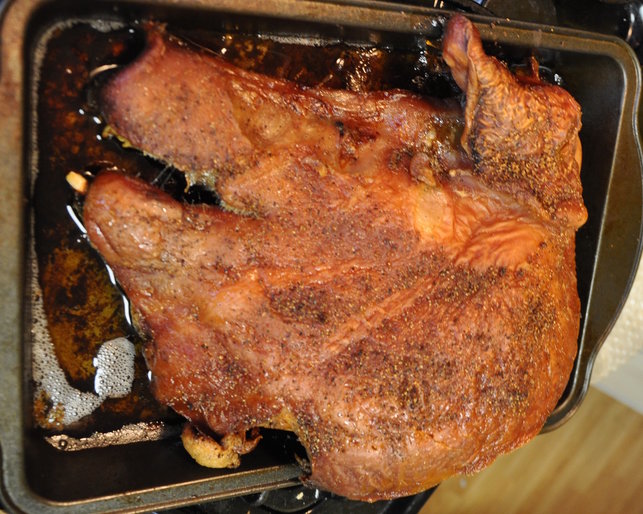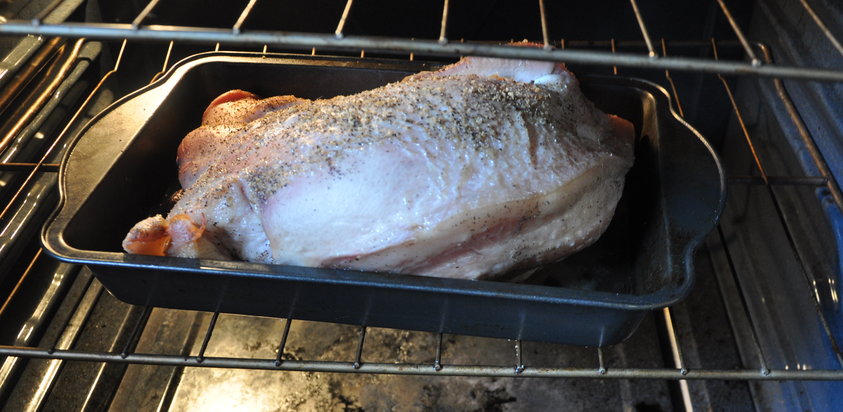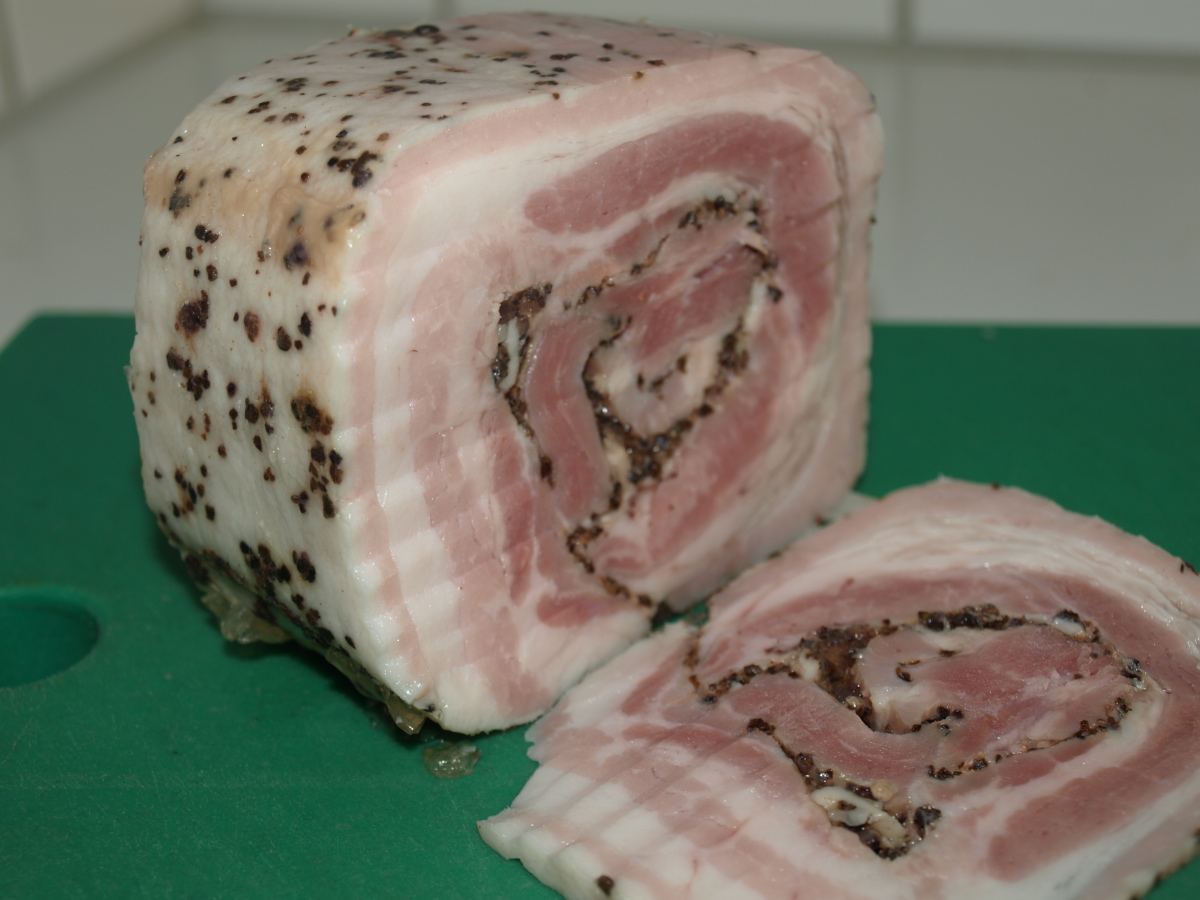| « SmallBar Division to Close | Local Restaurateurs on Making it in Chicago » |
Recipe Tue Oct 21 2014
My Adventure Cooking Pig's Head
 I fancy myself a female Kevin Gillespie--a little thinner, Asian-er, less MIT-caliber. But that Southern pork spirit--it rages in my veins. From carnitas to gelatinous trotter, I've cooked my way through the pork body, but never have I tried the head. That changed a week ago, as I was skipping merrily through the ethnic market, perusing through the aisle of delectable meats. There Wilbur was, his cranium Ned-Stark'd and split in half, his glossy eyeballs staring at me from beneath the plastic packaging. Buy me, it called. I wanted to cook him. I had to cook him. So I tossed Wilbur into my shopping basket and headed home.
I fancy myself a female Kevin Gillespie--a little thinner, Asian-er, less MIT-caliber. But that Southern pork spirit--it rages in my veins. From carnitas to gelatinous trotter, I've cooked my way through the pork body, but never have I tried the head. That changed a week ago, as I was skipping merrily through the ethnic market, perusing through the aisle of delectable meats. There Wilbur was, his cranium Ned-Stark'd and split in half, his glossy eyeballs staring at me from beneath the plastic packaging. Buy me, it called. I wanted to cook him. I had to cook him. So I tossed Wilbur into my shopping basket and headed home.
Pork is a versatile product--you can make crispy skin and crispy ears, cheeks for tacos, bones and fat for tonkotsu ramen, and rest of offal goodness for headcheese. A pig's head is cheap because eyeballs, teeth, and snouts scare the utter shit out of people. You will not find this cut in Whole Foods, Jewel, or Mariano's, so your best bet will be ethnic markets. Half a pig's head cost me roughly $7, so a whole head will average around $15. A suckling pig (baby pig) will cost significantly more.
 PREPARATION
PREPARATION
To sanitize the meat, I patted the head with salt and washed it off. I hesitantly lifted the pig ear and decided that I was not in favor of removing the eyeball. I was going to keep all the organs--brain included--intact because I presumed they would add flavor (read: I was too scared to remove the organs). Then, I found a spare Gillette shaver and started shaving the bristles off Wilbur. Shaving a pig's head might make you feel strange, so keep a bottle of wine on standby. Or whiskey. Or both.
Like a Thanksgiving turkey, I brined my head because doing so prevents meat from drying out during the roasting process. The standard rule for brining is 1 gallon of brine for every 6 lbs of meat. For my sweet brine, I mixed 1 cup of sugar and 1 cup of salt per every gallon of water (I used about 3 gallons to completely submerge the head). I also tossed in lots of garlic, herbs, and peppers for good measure. Some people boil and cool their brine before dumping in their meat, but I did not.
DRYING
After brining Wilbur in a plastic barrel for 48 hours, I removed the head and dried it on a roasting rack in the fridge for another 48 hours. You can brine and dry anywhere between 12-48 hours, but doing each step for as long as possible produces a crispier, more flavorful product. Take caution--roasting immediately after brining will mean your soggy meat will not crisp during the cooking process.
 ROASTING
ROASTING
Roasting is merely one cooking mechanism--some recipes call for boiling and others call for a sous-vide machine. But if you want crispy skin, you must roast the pig. I roasted Wilbur low and slow at 275 degrees for 5 hours, then at 375 for another 2 hours. I wrapped his ear in aluminum so it didn't burn. To make sure it was cooked through, I stuck a thermometer into the middle of his head to make sure the temperature was about 160 degrees (the suggested USDA guideline is 145-160). However, you can tell it's getting good when the skin starts to flush red and crisp up, and the fat begins to render and pool in the roasting rack. Also, pork smells sweeter when it's fully cooked. But in general, trust the thermometer.
EATING
I immediately consumed the pork cheeks because holy shit, they're delicious. They taste like pulled pork, but silkier and juicier, and on top of homemade tacos--Jesus. Because the meat is so intensely savory, you need an acid or spice element for balance. Also, you can throw away the solid fat and organs, but a resourceful person would save the scraps for headcheese. I kept the rendered head lard because pork fat is empirically superior to that healthy olive oil shit. Finally, you can re-cook the bones and scraps again in water for broth (esp for ramen).
 For $7, a pig head is an economical cut of meat. You get a lot of pig and a skull as a souvenir. Next time, I will wrap the entire head in aluminum during the first 5 hours because roasting in open air for 7 whole hours made the skin a little too crispy, almost glass-shatteringly crispy. But in general, I am extremely proud of my first time with head--I mean cooking it.
For $7, a pig head is an economical cut of meat. You get a lot of pig and a skull as a souvenir. Next time, I will wrap the entire head in aluminum during the first 5 hours because roasting in open air for 7 whole hours made the skin a little too crispy, almost glass-shatteringly crispy. But in general, I am extremely proud of my first time with head--I mean cooking it.









Alex Pearsons / November 4, 2014 12:20 AM
Looks great, though for best results, I highly recommend spinning it around hot coals. You'll get a more distinct flavor if you do so. Try roasting a whole suckling pig next time, though you'd need help putting on the spices. Try the recipes of Australian, Filipino and Indonesian roasted pigs. I also recommend stuffing some spices to add flavor too!